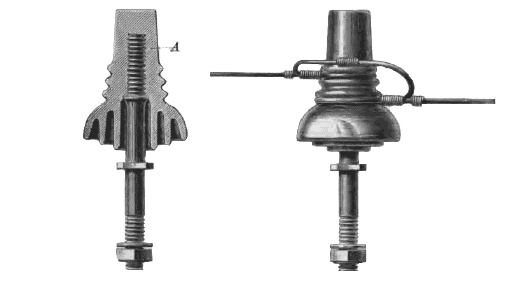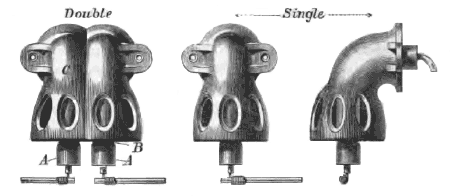[Trade Journal]
Publication: Journal of the Institute of Electrical Engineers
London, England
vol. 25, p. 392-394
INSULATION.
For many years a practice has prevailed of using a minor form of insulator for short circuits or block signaling wires. The author raises the question whether such a degree of refinement is desirable. It is inconvenient, inasmuch as it does not admit of interchange of wires where such changes are desirable. On the Midland the practice has long been abandoned. But one class of insulator, and one gauge of iron wire-—viz., No. 8— is employed. Thus, when required, through wires may be joined in with the shorter lengths, and the uniformity of the line preserved by maintaining the shorter lengths below the longer ones.
Moreover, it would appear that, however important other wires may be, none can be more important than those which govern the movements of the trains.
 |
| Fig. 5. |
It is believed that the best insulators are those known as the "Post Office" and the "corrugated;" samples of which are on the table.
Samples of the form of terminal insulator and leading-in cup, employed largely by others as well as by the author, are also before the meeting. The terminal insulator is made in two sizes, the smaller kind being employed where the strain is small, as, for instance, for leading across from one side of the line to the other for signal box and other like purposes. The larger kind is employed for terminations of line wires.
The great advantage of this insulator presides, not merely in the shape of the ware, but in the extent of the bolt, A (Fig. 5), which, it will be seen, passes far beyond the corrugations at which point the line wires are attached—a provision which renders it practically impossible for a wire to fall, even when the porcelain is from any cause broken. Another advantage is that these corrugations, or grooves, not only help the insulation, but make provision for the attachment of different gauges or different descriptions of wire, as, for instance, if it is desired to attach a No. 11 to a No. 8. If the No. 8 is placed in the lower groove, and the No. 11 in the upper groove, the strain on the bolt will be about equalised, and the insulator will retain its vertical position. They are equally useful for joining two descriptions of wire, say iron and copper, the one being terminated on one ring, and the other on another, the two wires being joined by a loop.
 |
| Fig. 6. |
At the termination of all important wires, and, in many instances, at important signal boxes, "leading-in" cups are employed. They are formed (Fig. 6) of a porcelain tube, A, which the G.P. wire is threaded, the tube being contracted at B so as to keep the wire central and free from the edges of the tube. This tube is protected by an iron hood, C, perforated, so as to admit of the rain cleansing the porcelain tube.
Where round creosoted poles are employed for leading-in wires, it is necessary to carry the G.P. wires in boxing fixed between the arms. If this boxing is strongly made it will admit of the leading-in cups being fixed to either side of it, and will thus form a very complete and durable termination.
